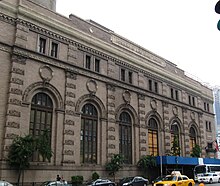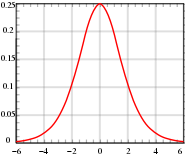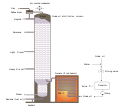| Main page | New articles & Tasks |
 The Energy Portal Welcome to Wikipedia's Energy portal, your gateway to energy. This portal is aimed at giving you access to all energy related topics in all of its forms.
|
Page contents: Selected article • Selected image • Selected biography • Did you know? • General images • Quotations • Related portals • Wikiprojects • Major topics • Categories • Help • Associated Wikimedia |
Introduction
Energy (from Ancient Greek ἐνέργεια (enérgeia) 'activity') is the quantitative property that is transferred to a body or to a physical system, recognizable in the performance of work and in the form of heat and light. Energy is a conserved quantity—the law of conservation of energy states that energy can be converted in form, but not created or destroyed; matter and energy may also be converted to one another. The unit of measurement for energy in the International System of Units (SI) is the joule (J).
Forms of energy include the kinetic energy of a moving object, the potential energy stored by an object (for instance due to its position in a field), the elastic energy stored in a solid object, chemical energy associated with chemical reactions, the radiant energy carried by electromagnetic radiation, the internal energy contained within a thermodynamic system, and rest energy associated with an object's rest mass.
All living organisms constantly take in and release energy. The Earth's climate and ecosystems processes are driven primarily by radiant energy from the sun. The energy industry provides the energy required for human civilization to function, which it obtains from energy resources such as fossil fuels, nuclear fuel, renewable energy, and geothermal energy. (Full article...)
Selected article
The IRT Powerhouse, also known as the Interborough Rapid Transit Company Powerhouse, is a former power station of the Interborough Rapid Transit Company (IRT), which operated the New York City Subway's first line. The building fills a block bounded by 58th Street, 59th Street, Eleventh Avenue, and Twelfth Avenue in the Hell's Kitchen and Riverside South neighborhoods of Manhattan.
The IRT Powerhouse was designed in the Renaissance Revival style by Stanford White, an architect working with the firm McKim, Mead & White, and was intended to serve as an aboveground focal point for the IRT. The facade is made of granite, brick, and terracotta, incorporating extensive ornamentation. The interiors were designed by engineers John van Vleck, Lewis B. Stillwell, and S. L. F. Deyo. At its peak, the powerhouse could generate more than 100,000 horsepower (75,000 kW). (Full article...)
Selected image

Photo credit: Postdlf
Lightning is a highly visible form of energy transfer.
Did you know?
- During World War I, the German Army produced shale oil from Yarmouk oil shale deposits in Jordan to operate the Hijazi Railway (pictured)?
- Dennis Spurgeon, formerly chief operating officer at uranium supplier USEC Inc., became the United States Assistant Secretary for Nuclear Energy in 2006?
- Japan Canada Oil Sands Limited was the first offshore oil company to exploit the Athabasca oil sands in Canada?
- Teesside Power Station is the largest combined-cycle gas turbine (CCGT) plant in Europe.?
- The Klaipėda Geothermal Demonstration Plant in Lithuania was the first geothermal plant in the Baltic Sea region?
- Hitachi Zosen Corporation built the first oil tanker in Japan in 1908 per an order by Standard Oil Company?
- Coalbed methane is a form of natural gas extracted from coal beds?
- When constructed in 1906, the Baku–Batumi pipeline was the world's longest kerosene pipeline?
Selected biography
Born in Texas, Hubbert studied geology, mathematics, and physics at the University of Chicago. He pursued his Ph.D. while working for the Amerada Petroleum Company, then worked for the Shell Oil Company from 1943 until 1964. On leaving Shell he became a senior research geophysicist for the United States Geological Survey until retiring in 1976. Hubbert was also a professor at Stanford University and at UC Berkeley.
Hubbert is most well-known for his studies on the capacities of oil fields and natural gas reserves. He predicted that, for any given geographical area, the rate of petroleum production over time would resemble a bell curve. At the 1956 meeting of the American Petroleum Institute, Hubbert predicted that United States petroleum production would peak in the late 1960s or early 1970s. He became famous when his prediction came true in 1970.
In 1974, Hubbert projected that global oil production would peak in 1995 "if current trends continue". Various subsequent predictions have been made by others as trends have fluctuated in the intervening years. Hubbert's theory, and its implications for the world economy, remain controversial.
In the news
- 30 September 2024 – Coal phase-out
- The last coal-fired power station in the United Kingdom shuts down in Ratcliffe-on-Soar, Nottinghamshire, England, ending the 142-year history of coal-fired electricity in the UK. (The Guardian)
- 20 September 2024 – Ukraine–European Union relations
- President of the European Commission Ursula von der Leyen announces a loan of up to €35 billion (US$39 billion) for Ukraine in military and energy support following Ukrainian President Volodymyr Zelenskyy's drafting of a new victory plan against Russia. (Reuters)
- 18 September 2024 – Israel–Hezbollah conflict
- Several home solar energy systems explode in Beirut, Lebanon. (ABC News)
General images
Quotations
- "The world's second-largest emitter of greenhouse gases is China. Yet, China was entirely exempted from the requirements of the Kyoto Protocol. India and Germany are among the top emitters. Yet, India was also exempt from Kyoto." – George W. Bush, 2001
- "The newly industrialized States cannot, for example, be asked to apply restrictive environmental standards to their emerging industries unless the industrialized States first apply them within their own boundaries." – Pope John Paul II, 1990
- "We should work together to make sure the international community upholds the goals and framework established in the United Nations Framework Convention on Climate Change and its Kyoto Protocol and the principle of common but differentiated responsibilities." – Hu Jintao, 2007
Related portals
WikiProjects
WikiProjects connected with energy:
Other WikiProjects that may be of interest:
Major topics
Major categories
National energy supply, use & conservation
National electricity sector
Politics, economics, environment
- Climate change
- Energy conservation
- Energy economics
- Energy crises
- Energy development
- Energy policy
- Peak oil
Energy sources
- Fuels
- Biofuels
- Fossil fuels
- Fusion power
- Nuclear technology
- Renewable energy
- Energy conversion
- Electric power
- Energy storage
Energy-related design
Scientific usage
Help

Puzzled by energy?
Can't answer your question?
Don't understand the answer?
- Ask at the reference desk
- Read the Wikipedia help pages
For further ideas, to leave a comment, or to learn how you can help improve and update this portal, see the talk page.
Associated Wikimedia
The following Wikimedia Foundation sister projects provide more on this subject:
-
Commons
Free media repository -
Wikibooks
Free textbooks and manuals -
Wikidata
Free knowledge base -
Wikinews
Free-content news -
Wikiquote
Collection of quotations -
Wikisource
Free-content library -
Wikiversity
Free learning tools -
Wiktionary
Dictionary and thesaurus



























































































































































































